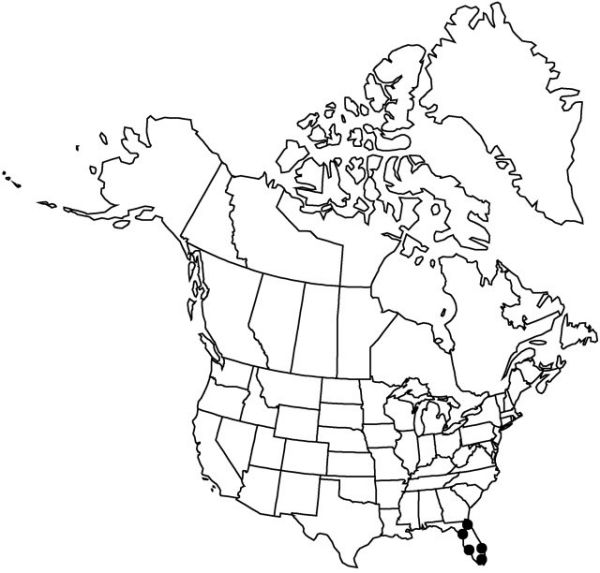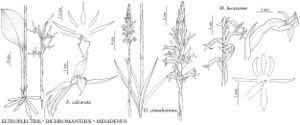Mesadenus lucayanus
Beih. Bot. Centralbl. 37: 368. 1920.
Plants to 60 cm. Roots several, 1.5–5 cm × 5–15 mm. Stems subterranean. Leaves spreading, pale green to gray-green, 3–5, glabrous; petiole 0.5–5 cm; blade lanceolate, elliptic to oblanceolate, 2–10.9 × 0.8–3.3 cm, apex obtuse, acute, or acuminate. Inflorescences glabrous; scapes 6.5–30 cm; bracts numerous, overlapping proximally, distant distally; racemes many-flowered, 6.5–29 cm; floral bracts erect, lanceolate, 3–4.5 mm, apex acuminate. Flowers reflexed, brownish green to coppery, slightly swollen basally, subsalverform, glabrous; sepals linearlanceolate; dorsal sepal 4–6 × 0.7–1.2 mm; lateral sepals basally connate 1–1.5 mm, falcate, 4–6.5 × 0.7–1.2 mm; petals connate and adnate to dorsal sepal, falcate, linearlanceolate, 4–5 × 0.5–1.2 mm; lip sometimes auriculate, short-unguiculate, elliptic-lanceolate to ovatelanceolate, 3.5–6 × 1–2.5 mm, apex obtuse-rounded; column clavate, 2–2.5 mm; pedicellate ovary erect, subsessile, 2.5–4 mm, apically geniculate. Capsules ovoid, 4–6 mm.
Phenology: Flowering winter–early spring (late Dec–Mar).
Habitat: Oak forests, in rocky soil
Elevation: 0–30 m
Distribution

Fla., Mexico, West Indies
Discussion
Mesadenus lucayanus is known in the flora area only from a few small populations in Citrus, Duval, and Miami-Dade counties (R. P. Wunderlin et al. 1996). Recent collections from Sarasota County are available, but the population has been extirpated (P. M. Brown 2002).
Mesadenus lucayanus has often been regarded as a synonym of M. polyanthus; however, I have decided that the two taxa are distinct. Mesadenus polyanthus is a robust Mexican species from dry, volcanic habitats at high elevations (1500–2250 m). Plants may reach 95 cm and the lower stem bracts are spreading, to 7.5 cm. The inflorescence is very congested, 10 mm thick. The perianth is attenuate (lateral sepals to 10 mm) with a narrowly lanceolate lip giving the flowers a very spidery appearance. Morphologic variation is subdued. On the other hand, M. lucayanus occurs at low elevations over calcareous soils. The plants are smaller, more slender, and the stem bracts are erect. The inflorescence is laxly flowered, and the perianth is generally smaller than that of M. polyanthus. The lip is elliptic-lanceolate to narrowly ovate. Although M. lucayanus is highly variable in many features, including flower color, the two taxa appear to differ substantially in both morphologic features as well as habitat requirements.
Selected References
None.
